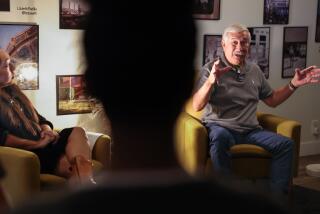âFriday Night Lightsâ fumbles opportunity
Like the book on which it is based, âFriday Night Lightsâ purports to chronicle the pursuit of a state football championship by Permian High School in Odessa, Texas. But the film is blatantly dishonest and disingenuous in omitting the single biggest thing that typified black, Latino and white relations in Odessa and many other small, dusty Texas towns as late as the 1980s. That thing is racism.
There were two huge early warning signs that âFriday Night Lightsâ might step gingerly around, if not outright expunge, the raw racism that deeply scarred relations among blacks, Latinos and whites in football-crazed Odessa.
The first was the reaction to the book. When âFriday Night Lightsâ was published in 1990, city officials and townspeople roundly vilified the writer, H.G. Bissinger. They charged that he grossly slandered the achievements of Permian Highâs football players, coaches and the city with his biting inside look (he lived in Odessa for a year) at not only the football mania that gripped the town but also the unrelenting racism that indelibly stamped it.
The second signal was the promise that âFriday Night Lightsâ filmmaker Peter Berg made to the Odessa school board not to portray the town in a racist or stereotypical way. Sanitizing racial conflict and exploitation was the price the filmmakers had to pay to get permission to film at Permianâs stadium.
But Odessa was a racist town in the 1980s. Residential segregation and job discrimination were as much a way of life there as the strip malls, the honky-tonk beer joints and the rusting oil derricks that dotted the areaâs landscape. Many whites tossed the âN-wordâ around so casually and routinely that few thought it offensive. A decade after many high schools in the deeper South states of Mississippi and Alabama had integrated their schools, Odessa officials were still bitterly resisting school integration. It took protests, marches and lengthy court battles to get the schools integrated.
Even then, school officials cynically viewed integration not as a chance to improve educational opportunities for minorities but as a way to get a steady supply of blue-chip black running backs to ensure that Permian High stayed in the thick of the hunt for more state championships.
In his review of the movie, Times film critic Kenneth Turan rightly noted that âFriday Night Lightsâ played fast and loose with the facts [âHut 1 ... Hut 2 ... Hype!,â Oct. 8]. That even included depicting blacks as the sole bigots. The black coaches of the all-black team that faces Permian High in the championship game complain bitterly about the initial lack of black officials; during the game they wink and nod at the black playersâ showboating and dirty play. A black referee blatantly cheats on a call in favor of the black team.
This depiction reinforces the widespread notion that racism is a part of Americaâs bygone past and that race becomes an issue only when blacks or Latinos scream about it -- or worse, as the film implies, when they commit racial abuses against whites.
That lets those whites who expressed their bigotry off the hook. Itâs not clear if the passage of time has entirely softened that bigotry. In an afterword to his book, Bissinger claims that the townâs football mania has dissipated, academics are taken much more seriously, and thereâs a greater social open- ness there than a decade ago. My suspicion is that any change with regard to race relations has been slow and grudging.
The filmâs glaring racial blind spot could have been overlooked if it had simply told the tale of how a group of gritty, undersized overachievers overcame the odds, attained sports greatness and along the way brought a town together. That guts-and-glory tale of triumph has long been a staple of sports genre films. They always give audiences an adrenaline rush of pride and good feeling.
The film could have also been a cautionary tale of the corrosive and corrupting effect that the single-minded pursuit of gridiron fame has on the lives of many young men.
âFriday Night Lightsâ could have even stood racism on its head and shown that, despite Odessaâs long history of racial abuse and division, football was the vehicle that black, Latino and white teens used to forge a bond of brotherhood in their quest for victory. That would have elevated âFriday Night Lightsâ from just another rah-rah sports film to a movie of true triumph. Sadly, it punted away the chance to be that kind of film.
More to Read
Sign up for our Book Club newsletter
Get the latest news, events and more from the Los Angeles Times Book Club, and help us get L.A. reading and talking.
You may occasionally receive promotional content from the Los Angeles Times.







